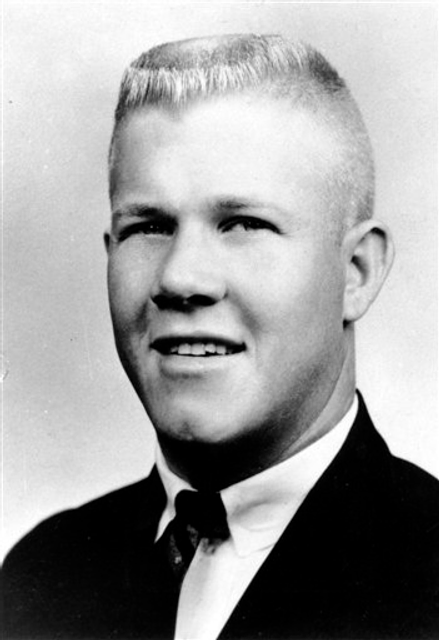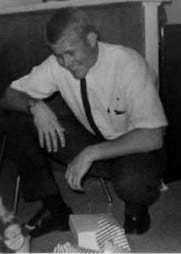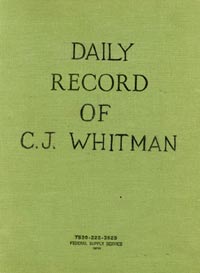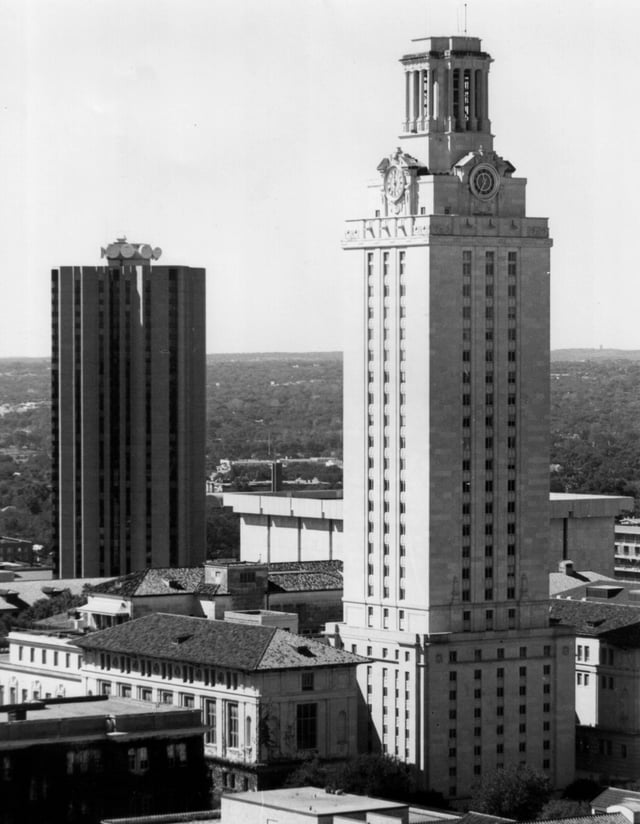Charles Whitman

Charles Whitman

Charles Whitman | |
|---|---|
| Born | Charles Joseph Whitman (1941-06-24)June 24, 1941 Lake Worth, Florida, U.S. |
| Died | August 1, 1966(1966-08-01)(aged 25) Austin, Texas, U.S. |
| Cause of death | Multiple handgun and shotgun wounds |
| Resting place | Hillcrest Memorial Park, West Palm Beach, Florida, U.S. |
| Other names | The Texas Tower Sniper |
| Spouse(s) | Kathy Leissner (m. 1962–1966) |
| Parent(s) | Charles Adolphus Whitman Jr. Margaret Whitman |
| Details | |
| Date | August 1, 1966 Family:c.12:15 a.m. – 3:00 a.m. Random: 11:48 a.m. – 1:24 p.m. |
| Location(s) | University of Texas at Austin, Texas |
| Target(s) | Mother, wife, random strangers |
| Killed | 17 (including an unborn baby and David Gunby, who died in 2001)[2] |
| Injured | 31 |
| Weapons |
|
Charles Joseph Whitman (June 24, 1941 – August 1, 1966) was an American mass murderer who became infamous as the "Texas Tower Sniper". On August 1, 1966, he used knives in the slayings of his mother and his wife in their respective homes and then went to the University of Texas in Austin with multiple firearms and began indiscriminately shooting at people. He fatally shot three people inside the university tower. He then went to the tower's 28th-floor observation deck, where he fired at random people for some 96 minutes, killing an additional 11 people (including an unborn child), and wounding 31 others before he was shot dead by Austin police officer Houston McCoy. Whitman killed a total of 17 people; the 17th victim died 35 years later from injuries sustained in the attack.[3][4][5][6]
Charles Whitman | |
|---|---|
| Born | Charles Joseph Whitman (1941-06-24)June 24, 1941 Lake Worth, Florida, U.S. |
| Died | August 1, 1966(1966-08-01)(aged 25) Austin, Texas, U.S. |
| Cause of death | Multiple handgun and shotgun wounds |
| Resting place | Hillcrest Memorial Park, West Palm Beach, Florida, U.S. |
| Other names | The Texas Tower Sniper |
| Spouse(s) | Kathy Leissner (m. 1962–1966) |
| Parent(s) | Charles Adolphus Whitman Jr. Margaret Whitman |
| Details | |
| Date | August 1, 1966 Family:c.12:15 a.m. – 3:00 a.m. Random: 11:48 a.m. – 1:24 p.m. |
| Location(s) | University of Texas at Austin, Texas |
| Target(s) | Mother, wife, random strangers |
| Killed | 17 (including an unborn baby and David Gunby, who died in 2001)[2] |
| Injured | 31 |
| Weapons |
|
Early life and education
Whitman was born on June 24, 1941, in Lake Worth, Florida, the eldest of three sons born to Margaret E. (Hodges) and Charles Adolphus "C. A." Whitman Jr.[7] Whitman's father was raised in an orphanage in Savannah, Georgia,[8] and described himself as a self-made man. In 1940, he married Margaret, then 17 years old. The marriage of Whitman's parents was marred by domestic violence; Whitman's father was an admitted authoritarian who provided for his family but demanded near perfection from all of them. He was known to physically and emotionally abuse his wife and children.[9]
As a boy, Whitman was described as a polite child who seldom lost his temper.[10] He was extremely intelligent—an examination at the age of six revealed his IQ to be 139.[11] Whitman's academic achievements were encouraged by his parents, yet any indication of failure or a lethargic attitude were met with discipline—often physical—from his father.[12]
Margaret Whitman was a devout Roman Catholic who raised her sons in the same religion. The Whitman brothers regularly attended Mass with their mother, and all three brothers served as altar boys at the Sacred Heart Roman Catholic Church.[13]
Whitman Sr. was a firearms collector and enthusiast, who taught each of his young sons to shoot, clean, and maintain weapons. He regularly took them on hunting trips, and Charles became an avid hunter and accomplished marksman. His father said of him: "Charlie could plug the eye out of a squirrel by the time he was sixteen."[14]
High school

Whitman around 1959 (age 18)
On September 1, 1955, Whitman entered St. Ann's High School in West Palm Beach, where he was regarded as a moderately popular student whose intelligence was noted by his teachers and peers.[17] By the next month, he had saved enough money from his newspaper route to purchase a Harley-Davidson motorcycle, which he used on his route.[18]
Whitman enlisted in the United States Marine Corps one month after his June 1959 graduation from high school, where he had graduated seventh in a class of 72 students.[8] He had not told his father beforehand. Whitman told a family friend that the catalyst was an incident a month earlier, in which his father had beaten him and thrown him into the family swimming pool because Whitman had come home drunk.[9] Whitman left home on July 6, having been assigned an 18-month tour of duty with the Marines at Guantánamo Bay. His father still did not know he had enlisted.[8]
As Whitman traveled toward Parris Island, his father learned of his action and telephoned a branch of the federal government, trying to have his son's enlistment canceled.[13]
U.S. Marine and college student
During Whitman's initial 18-month service in 1959 and 1960, he earned a sharpshooter's badge and the Marine Corps Expeditionary Medal. He achieved 215 of 250 possible points on marksmanship tests, doing well when shooting rapidly over long distances as well as at moving targets. After completing his assignment, Whitman applied to a U.S. Navy and Marine Corps scholarship program, intending to complete college and become a commissioned officer.[19]
Whitman earned high scores on the required examination, and the selection committee approved his enrollment at a preparatory school in Maryland, where he completed courses in mathematics and physics before being approved to transfer to the University of Texas at Austin to study mechanical engineering.[19]
University life
On September 15, 1961, Whitman entered the mechanical engineering program at the University of Texas at Austin. He was initially a poor student. His hobbies included karate, scuba diving, gambling, and hunting.[20] Shortly after his enrollment at the university, Whitman and two friends were observed poaching a deer, with a passer-by noting his license plate number and reporting them to the police. The trio were butchering the deer in the shower at Whitman's dormitory when they were arrested.[13] Whitman was fined $100 ($800 in 2018) for the offense.[21]
Whitman earned a reputation as a practical joker in his years as an engineering student, but his friends also noted he made some morbid and chilling statements. On one occasion in 1962, as Whitman and a fellow student named Francis Schuck Jr. browsed in the bookstore in the main building of the University of Texas, Whitman remarked, "A person could stand off an army from atop of it [the tower] before they got him."[22]
Marriage
In February 1962, 20-year-old Whitman met Kathleen Frances Leissner, an education major two years his junior. Leissner was Whitman's first serious girlfriend. They courted for five months before announcing their engagement on July 19.[23]
On August 17, 1962, Whitman and Leissner were married in a Catholic ceremony held in Leissner's hometown of Needville, Texas.[24] The couple chose the 22nd wedding anniversary of Whitman's parents as the date for their wedding.[22] Whitman's family drove from Florida to Texas to attend the event, and his younger brother Patrick served as best man. Fr. Leduc, a Whitman family friend, presided over the ceremony. Leissner's family and friends approved of her choice of husband, describing Whitman as a "handsome young man" who was both intelligent, and aspirational.[25]
Although Whitman's grades improved somewhat during his second and third semesters, the Marines considered them insufficient for continuation of his scholarship. He was ordered to active duty in February 1963[26] and went to Camp Lejeune, North Carolina, for the remainder of his five-year enlistment.[27]
Camp Lejeune
Despite his reputation as an exemplary Marine, he continued to gamble. In November 1963, he was court-martialed for gambling, usury, possession of a personal firearm on base, and for threatening another Marine over a $30 loan ($200 in 2018), for which he had demanded $15 in interest. Sentenced to 30 days of confinement and 90 days of hard labor, he was demoted from lance corporal (E-3) to private (E-1).[30]
Documented stressors

Whitman's journal
While awaiting his court martial in 1963, Whitman began to write a diary titled Daily Record of C. J. Whitman.[31] In it, he wrote about his daily life in the Marine Corps and his interactions with Kathy and other family members. He also wrote about his upcoming court martial and contempt for the Marine Corps, criticizing them for inefficiencies. In his writings about his wife, Whitman often praised her and expressed his longing to be with her. He also wrote about his efforts and plans to free himself from financial dependence on his father.[32]
In December 1964, Whitman was honorably discharged from the Marines. He returned to the University of Texas at Austin, enrolling in the architectural engineering program. To support Kathy and himself, he worked as a bill collector for the Standard Finance Company. Later, he worked as a bank teller at the Austin National Bank. In January 1965, Whitman took a temporary job with Central Freight Lines as a traffic surveyor for the Texas Highway Department.[33][34] He also volunteered as a scout leader for Austin Scout Troop 5, while his wife Kathy now worked as a biology teacher at Lanier High School.[35]
Friends later said that Whitman had told them that he struck his wife on two occasions.[36] They said that Whitman despised himself for this and confessed to being "mortally afraid of being like his father."[37] In his journal, Whitman lamented his actions and resolved to be a good husband and not abusive as his father had been.[37]
Separation of Whitman's parents
In May 1966, Margaret Whitman announced her decision to divorce her husband because of his continued physical abuse.[38] Charles Whitman drove to Florida to help his mother move to Austin. Whitman was reportedly so afraid that his father would resort to violence against his mother as she prepared to leave, he summoned a local policeman to remain outside the house while his mother packed her belongings.[38] Whitman's youngest brother, John, also left Lake Worth and moved to Austin with his mother. Patrick Whitman, the middle son, remained in Florida and worked in his father's plumbing supply business.[39]
In Austin, Whitman's mother took a job in a cafeteria and moved into her own apartment, though she remained in close contact with Charles.[38] Whitman's father later said he had spent more than a thousand dollars ($8,200 in 2018) on long-distance phone calls to both his wife and Charles, begging his wife to return and asking his son to convince her to come back.[38] During this stressful time, Whitman was abusing amphetamines and began experiencing severe headaches, which he described as being "tremendous".
Events leading to the shooting

Main building of the University of Texas at Austin. Whitman went up to the observation deck and fired upon people at ground level.
The day before the shootings, Whitman bought a pair of binoculars and a knife from a hardware store, and some Spam from a 7-Eleven convenience store. He picked up his wife from her summer job as a telephone operator before he met his mother for lunch at the Wyatt Cafeteria, which was close to the university.[40]
At about 4:00 p.m. on July 31, 1966, Charles and Kathy Whitman visited their close friends John and Fran Morgan. They left the Morgans' apartment at 5:50 p.m. so Kathy could get to her 6:00–10:00 p.m. shift.[40]
At 6:45 p.m., Whitman began typing his suicide note, a portion of which read:
I do not quite understand what it is that compels me to type this letter. Perhaps it is to leave some vague reason for the actions I have recently performed. I do not really understand myself these days. I am supposed to be an average reasonable and intelligent young man. However, lately (I cannot recall when it started) I have been a victim of many unusual and irrational thoughts. These thoughts constantly recur, and it requires a tremendous mental effort to concentrate on useful and progressive tasks.[41]
In his note, he went on to request an autopsy be performed on his remains after he was dead to determine if there had been a discernible biological contributory cause for his actions and for his continuing and increasingly intense headaches. He also wrote that he had decided to kill both his mother and wife. Expressing uncertainty about his reasons, he nonetheless stated he did not believe his mother had "ever enjoyed life as she is entitled to",[40] and that his wife had "been as fine a wife to me as any man could ever hope to have". Whitman further explained that he wanted to relieve both his wife and mother of the suffering of this world, and to save them the embarrassment of his actions. He did not mention planning the attack at the university.[42]
Just after midnight on August 1, Whitman drove to his mother's apartment at 1212 Guadalupe Street. After killing his mother, he placed her body on her bed and covered it with sheets.[43] Just how he murdered his mother is disputed, but officials believed he rendered her unconscious before stabbing her in the heart.[43]
He left a handwritten note beside her body, which read in part:
To Whom It May Concern: I have just taken my mother's life. I am very upset over having done it. However, I feel that if there is a heaven she is definitely there now [...] I am truly sorry [...] Let there be no doubt in your mind that I loved this woman with all my heart.[44]
Whitman then returned to his home at 906 Jewell Street, where he killed his wife by stabbing her three times in the heart as she slept. He covered her body with sheets, then resumed the typewritten note he had begun the previous evening.[45] Using a ballpoint pen, he wrote at the side of the page:
Friends interrupted. 8-1-66 Mon. 3:00 A.M. BOTH DEAD.[43]
Whitman continued the note, finishing it by pen:
I imagine it appears that I brutally killed both of my loved ones. I was only trying to do a quick thorough job [...] If my life insurance policy is valid please pay off my debts [...] donate the rest anonymously to a mental health foundation. Maybe research can prevent further tragedies of this type [...] Give our dog to my in-laws. Tell them Kathy loved "Schocie" very much [...] If you can find in yourselves to grant my last wish, cremate me after the autopsy.[41]
He also left instructions in the rented house requesting that two rolls of camera film be developed and wrote personal notes to each of his brothers.[43]
Whitman last wrote on an envelope labeled "Thoughts for the Day", in which he stored a collection of written admonitions. He added on the outside of the envelope:
8-1-66. I never could quite make it. These thoughts are too much for me.[43]
At 5:45 a.m. on August 1, 1966, Whitman phoned his wife's supervisor at Bell System to explain that Kathy was ill and unable to work that day. He made a similar phone call to his mother's workplace five hours later.
Whitman's final journal entries were written in the past tense, suggesting that he had already killed his wife and mother.[41]
University of Texas Tower shooting

The tower observation deck
At approximately 11:35 a.m.,[46] Whitman arrived on the University of Texas at Austin campus. He falsely identified himself as a research assistant and told a security guard he was there to deliver equipment.[46] He then climbed to the 28th floor of the UT tower, killing three people within the tower, and opened fire from the observation deck with a hunting rifle and other weapons.[47]
Death and inquest
Medical history
Investigating officers found that Whitman had visited several University doctors in the year before the shootings; they prescribed various medications for him. Whitman had seen a minimum of five doctors between the fall and winter of 1965, before he visited a psychiatrist from whom he received no prescription. At some other time he was prescribed Valium by Dr. Jan Cochrum, who recommended he visit the campus psychiatrist.[52]
Whitman met with Maurice Dean Heatly, the staff psychiatrist at the University of Texas Health Center, on March 29, 1966.[53] Whitman referred to his visit with Heatly in his final suicide note, writing, "I talked with a Doctor once for about two hours and tried to convey to him my fears that I felt come [sic] overwhelming violent impulses. After one visit, I never saw the Doctor again, and since then have been fighting my mental turmoil alone, and seemingly to no avail."[41]
Heatly's notes on the visit said, "This massive, muscular youth seemed to be oozing with hostility [...] that something seemed to be happening to him and that he didn't seem to be himself."[54] "He readily admits having overwhelming periods of hostility with a very minimum of provocation. Repeated inquiries attempting to analyze his exact experiences were not too successful with the exception of his vivid reference to 'thinking about going up on the tower with a deer rifle and start shooting people.'"[55]
Autopsy
Although Whitman had been prescribed drugs and was in possession of Dexedrine at the time of his death, the toxicology was delayed because Whitman had been embalmed on August 1, after his body was brought to the Cook Funeral Home in Austin. However, an autopsy had been requested in the suicide notes left by Whitman and was then approved by his father.[56]
On August 2, an autopsy was conducted by Coleman de Chenar (a neuropathologist at Austin State Hospital) at the funeral home. Urine and blood were removed to test for traces of amphetamines or other substances.[57][58] During the autopsy, Chenar discovered a "pecan-sized" brain tumor,[59] which he labeled an astrocytoma and which exhibited a small amount of necrosis. Chenar concluded that the tumor had no effect on Whitman's actions. These findings were later revised by the Connally Commission: "It is the opinion of the task force that the relationship between the brain tumor and Charles J. Whitman's actions on the last day of his life cannot be established with clarity."[60]
Connally Commission
Texas Governor John Connally commissioned a task force to examine the autopsy findings and material related to Whitman's actions and motives. The commission was composed of neurosurgeons, psychiatrists, pathologists, psychologists, and the University of Texas Health Center Directors, John White and Maurice Heatly. The Commission's toxicology tests revealed nothing significant. They examined Chenar's paraffin blocks of the tumor, stained specimens of it and Whitman's other brain tissue, in addition to the remainder of the autopsy specimens available.[61]
Following a three-hour hearing on August 5,[62] the Commission concluded that Chenar's finding had been in error.[63] They found that the tumor had features of a glioblastoma multiforme, with widespread areas of necrosis, palisading[1] of cells,[60] and a "remarkable vascular component" described as having "the nature of a small congenital vascular malformation". Psychiatric contributors to the report concluded that "the relationship between the brain tumor and [...] Whitman's actions [...] cannot be established with clarity. However, the [...] tumor conceivably could have contributed to his inability to control his emotions and actions",[64] while the neurologists and neuropathologists concluded: "The application of existing knowledge of organic brain function does not enable us to explain the actions of Whitman on August first."[65]
Funeral
See also
List of disasters in the United States by death toll
List of rampage killers (school massacres)
The Deadly Tower